PUN210 Case Study: HIV/AIDS Patient Education Model & Discharge
VerifiedAdded on 2023/06/11
|17
|4163
|315
Case Study
AI Summary
This case study addresses the need for improved patient education for HIV/AIDS patients at the time of hospital discharge to reduce readmission rates. It identifies key staff members involved in the model, including medical staff, nurses, pharmacists, nutrition specialists, clinical social workers, counselors, and hospital administration, and discusses their roles in educating patients on medication adherence, preventive measures, and risk reduction. The study also outlines potential barriers to staff involvement, such as incivility, lack of understanding of patient learning needs, time constraints, and inadequate training, and proposes solutions to overcome these challenges. Furthermore, it details the planning processes involved, including instructional design principles, mission statement development, and resource allocation. It also identifies the types of information needed and their sources and presents an original diagram of the planning process for the new patient education model. The goal is to create a comprehensive and effective patient education program that improves patient outcomes and reduces healthcare costs.
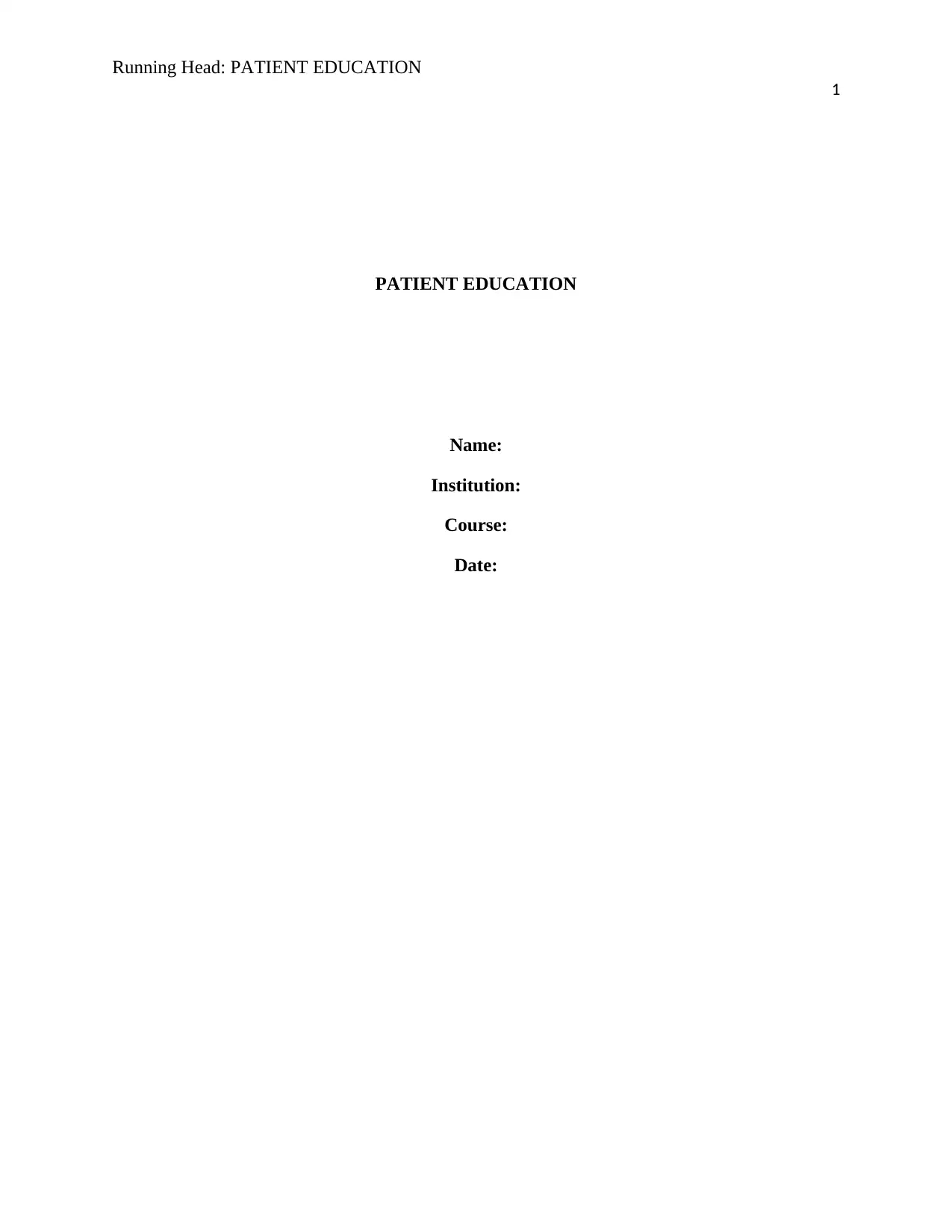
Running Head: PATIENT EDUCATION
1
PATIENT EDUCATION
Name:
Institution:
Course:
Date:
1
PATIENT EDUCATION
Name:
Institution:
Course:
Date:
Paraphrase This Document
Need a fresh take? Get an instant paraphrase of this document with our AI Paraphraser
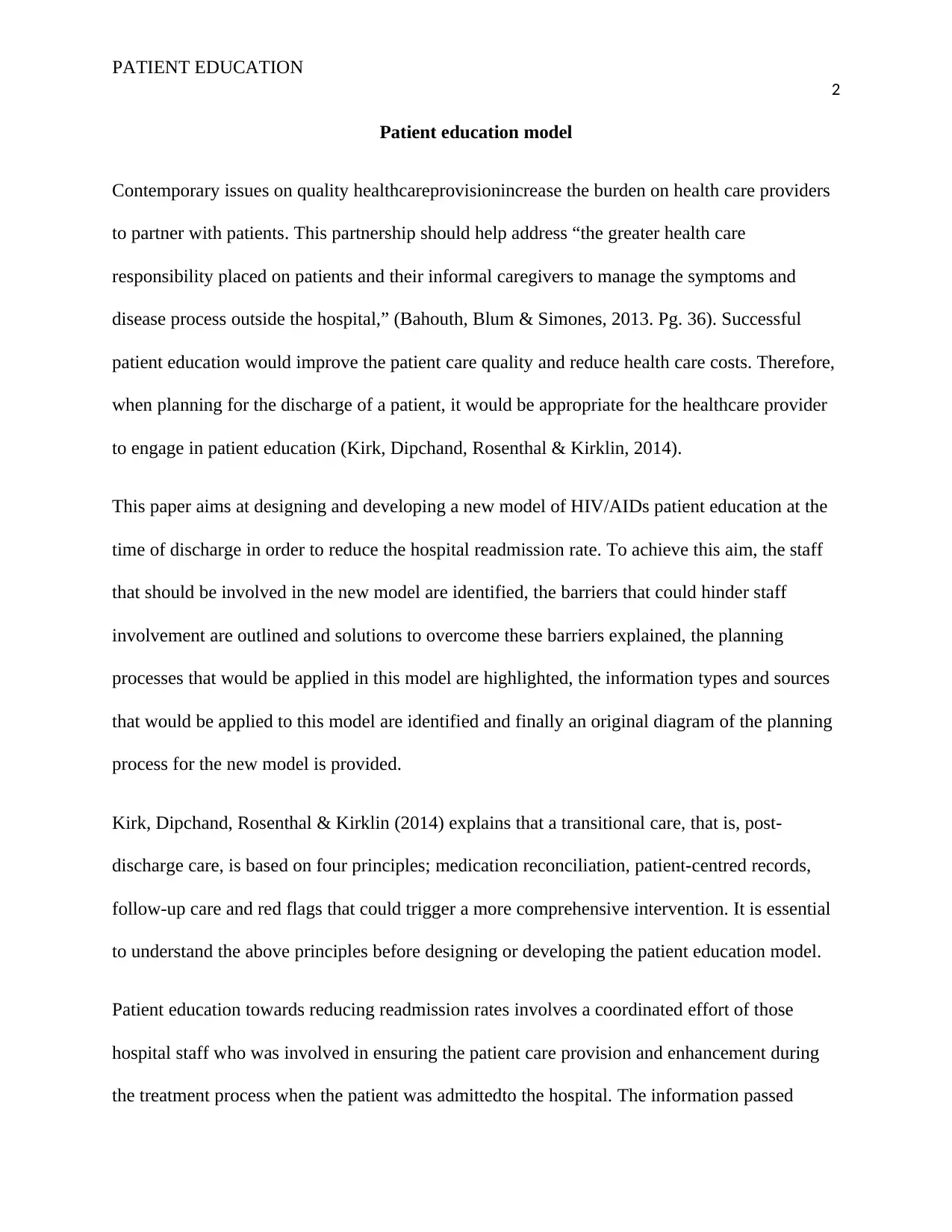
PATIENT EDUCATION
2
Patient education model
Contemporary issues on quality healthcareprovisionincrease the burden on health care providers
to partner with patients. This partnership should help address “the greater health care
responsibility placed on patients and their informal caregivers to manage the symptoms and
disease process outside the hospital,” (Bahouth, Blum & Simones, 2013. Pg. 36). Successful
patient education would improve the patient care quality and reduce health care costs. Therefore,
when planning for the discharge of a patient, it would be appropriate for the healthcare provider
to engage in patient education (Kirk, Dipchand, Rosenthal & Kirklin, 2014).
This paper aims at designing and developing a new model of HIV/AIDs patient education at the
time of discharge in order to reduce the hospital readmission rate. To achieve this aim, the staff
that should be involved in the new model are identified, the barriers that could hinder staff
involvement are outlined and solutions to overcome these barriers explained, the planning
processes that would be applied in this model are highlighted, the information types and sources
that would be applied to this model are identified and finally an original diagram of the planning
process for the new model is provided.
Kirk, Dipchand, Rosenthal & Kirklin (2014) explains that a transitional care, that is, post-
discharge care, is based on four principles; medication reconciliation, patient-centred records,
follow-up care and red flags that could trigger a more comprehensive intervention. It is essential
to understand the above principles before designing or developing the patient education model.
Patient education towards reducing readmission rates involves a coordinated effort of those
hospital staff who was involved in ensuring the patient care provision and enhancement during
the treatment process when the patient was admittedto the hospital. The information passed
2
Patient education model
Contemporary issues on quality healthcareprovisionincrease the burden on health care providers
to partner with patients. This partnership should help address “the greater health care
responsibility placed on patients and their informal caregivers to manage the symptoms and
disease process outside the hospital,” (Bahouth, Blum & Simones, 2013. Pg. 36). Successful
patient education would improve the patient care quality and reduce health care costs. Therefore,
when planning for the discharge of a patient, it would be appropriate for the healthcare provider
to engage in patient education (Kirk, Dipchand, Rosenthal & Kirklin, 2014).
This paper aims at designing and developing a new model of HIV/AIDs patient education at the
time of discharge in order to reduce the hospital readmission rate. To achieve this aim, the staff
that should be involved in the new model are identified, the barriers that could hinder staff
involvement are outlined and solutions to overcome these barriers explained, the planning
processes that would be applied in this model are highlighted, the information types and sources
that would be applied to this model are identified and finally an original diagram of the planning
process for the new model is provided.
Kirk, Dipchand, Rosenthal & Kirklin (2014) explains that a transitional care, that is, post-
discharge care, is based on four principles; medication reconciliation, patient-centred records,
follow-up care and red flags that could trigger a more comprehensive intervention. It is essential
to understand the above principles before designing or developing the patient education model.
Patient education towards reducing readmission rates involves a coordinated effort of those
hospital staff who was involved in ensuring the patient care provision and enhancement during
the treatment process when the patient was admittedto the hospital. The information passed
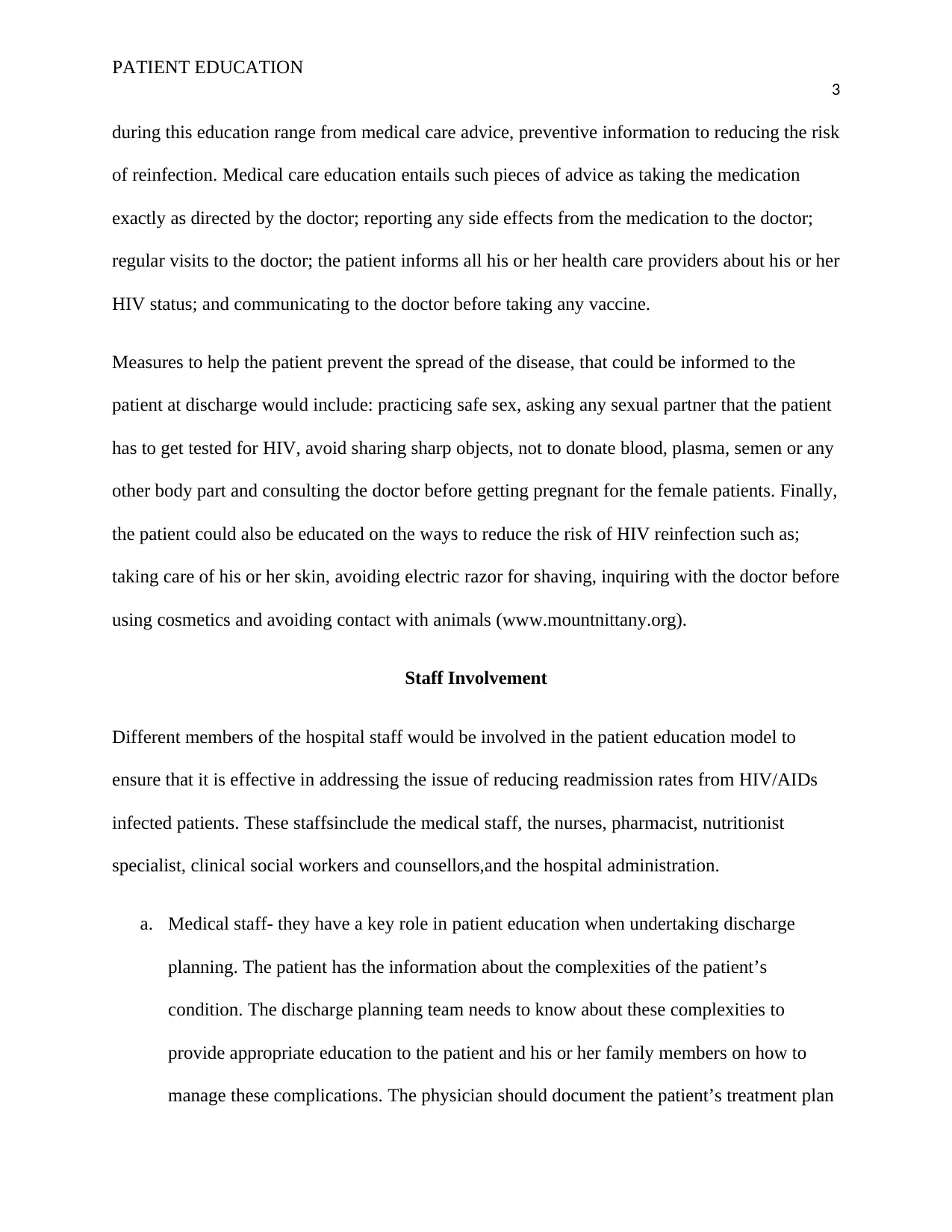
PATIENT EDUCATION
3
during this education range from medical care advice, preventive information to reducing the risk
of reinfection. Medical care education entails such pieces of advice as taking the medication
exactly as directed by the doctor; reporting any side effects from the medication to the doctor;
regular visits to the doctor; the patient informs all his or her health care providers about his or her
HIV status; and communicating to the doctor before taking any vaccine.
Measures to help the patient prevent the spread of the disease, that could be informed to the
patient at discharge would include: practicing safe sex, asking any sexual partner that the patient
has to get tested for HIV, avoid sharing sharp objects, not to donate blood, plasma, semen or any
other body part and consulting the doctor before getting pregnant for the female patients. Finally,
the patient could also be educated on the ways to reduce the risk of HIV reinfection such as;
taking care of his or her skin, avoiding electric razor for shaving, inquiring with the doctor before
using cosmetics and avoiding contact with animals (www.mountnittany.org).
Staff Involvement
Different members of the hospital staff would be involved in the patient education model to
ensure that it is effective in addressing the issue of reducing readmission rates from HIV/AIDs
infected patients. These staffsinclude the medical staff, the nurses, pharmacist, nutritionist
specialist, clinical social workers and counsellors,and the hospital administration.
a. Medical staff- they have a key role in patient education when undertaking discharge
planning. The patient has the information about the complexities of the patient’s
condition. The discharge planning team needs to know about these complexities to
provide appropriate education to the patient and his or her family members on how to
manage these complications. The physician should document the patient’s treatment plan
3
during this education range from medical care advice, preventive information to reducing the risk
of reinfection. Medical care education entails such pieces of advice as taking the medication
exactly as directed by the doctor; reporting any side effects from the medication to the doctor;
regular visits to the doctor; the patient informs all his or her health care providers about his or her
HIV status; and communicating to the doctor before taking any vaccine.
Measures to help the patient prevent the spread of the disease, that could be informed to the
patient at discharge would include: practicing safe sex, asking any sexual partner that the patient
has to get tested for HIV, avoid sharing sharp objects, not to donate blood, plasma, semen or any
other body part and consulting the doctor before getting pregnant for the female patients. Finally,
the patient could also be educated on the ways to reduce the risk of HIV reinfection such as;
taking care of his or her skin, avoiding electric razor for shaving, inquiring with the doctor before
using cosmetics and avoiding contact with animals (www.mountnittany.org).
Staff Involvement
Different members of the hospital staff would be involved in the patient education model to
ensure that it is effective in addressing the issue of reducing readmission rates from HIV/AIDs
infected patients. These staffsinclude the medical staff, the nurses, pharmacist, nutritionist
specialist, clinical social workers and counsellors,and the hospital administration.
a. Medical staff- they have a key role in patient education when undertaking discharge
planning. The patient has the information about the complexities of the patient’s
condition. The discharge planning team needs to know about these complexities to
provide appropriate education to the patient and his or her family members on how to
manage these complications. The physician should document the patient’s treatment plan
⊘ This is a preview!⊘
Do you want full access?
Subscribe today to unlock all pages.

Trusted by 1+ million students worldwide
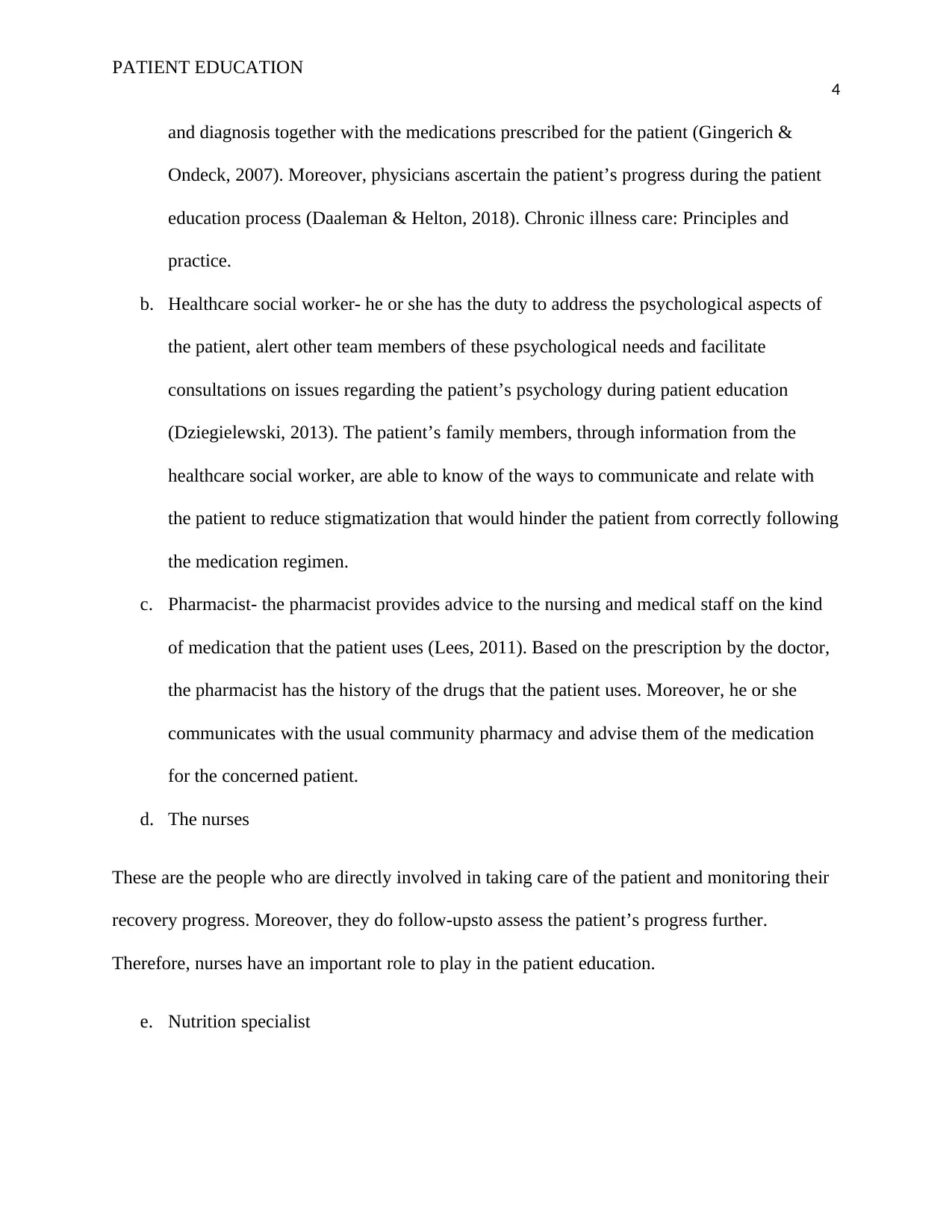
PATIENT EDUCATION
4
and diagnosis together with the medications prescribed for the patient (Gingerich &
Ondeck, 2007). Moreover, physicians ascertain the patient’s progress during the patient
education process (Daaleman & Helton, 2018). Chronic illness care: Principles and
practice.
b. Healthcare social worker- he or she has the duty to address the psychological aspects of
the patient, alert other team members of these psychological needs and facilitate
consultations on issues regarding the patient’s psychology during patient education
(Dziegielewski, 2013). The patient’s family members, through information from the
healthcare social worker, are able to know of the ways to communicate and relate with
the patient to reduce stigmatization that would hinder the patient from correctly following
the medication regimen.
c. Pharmacist- the pharmacist provides advice to the nursing and medical staff on the kind
of medication that the patient uses (Lees, 2011). Based on the prescription by the doctor,
the pharmacist has the history of the drugs that the patient uses. Moreover, he or she
communicates with the usual community pharmacy and advise them of the medication
for the concerned patient.
d. The nurses
These are the people who are directly involved in taking care of the patient and monitoring their
recovery progress. Moreover, they do follow-upsto assess the patient’s progress further.
Therefore, nurses have an important role to play in the patient education.
e. Nutrition specialist
4
and diagnosis together with the medications prescribed for the patient (Gingerich &
Ondeck, 2007). Moreover, physicians ascertain the patient’s progress during the patient
education process (Daaleman & Helton, 2018). Chronic illness care: Principles and
practice.
b. Healthcare social worker- he or she has the duty to address the psychological aspects of
the patient, alert other team members of these psychological needs and facilitate
consultations on issues regarding the patient’s psychology during patient education
(Dziegielewski, 2013). The patient’s family members, through information from the
healthcare social worker, are able to know of the ways to communicate and relate with
the patient to reduce stigmatization that would hinder the patient from correctly following
the medication regimen.
c. Pharmacist- the pharmacist provides advice to the nursing and medical staff on the kind
of medication that the patient uses (Lees, 2011). Based on the prescription by the doctor,
the pharmacist has the history of the drugs that the patient uses. Moreover, he or she
communicates with the usual community pharmacy and advise them of the medication
for the concerned patient.
d. The nurses
These are the people who are directly involved in taking care of the patient and monitoring their
recovery progress. Moreover, they do follow-upsto assess the patient’s progress further.
Therefore, nurses have an important role to play in the patient education.
e. Nutrition specialist
Paraphrase This Document
Need a fresh take? Get an instant paraphrase of this document with our AI Paraphraser
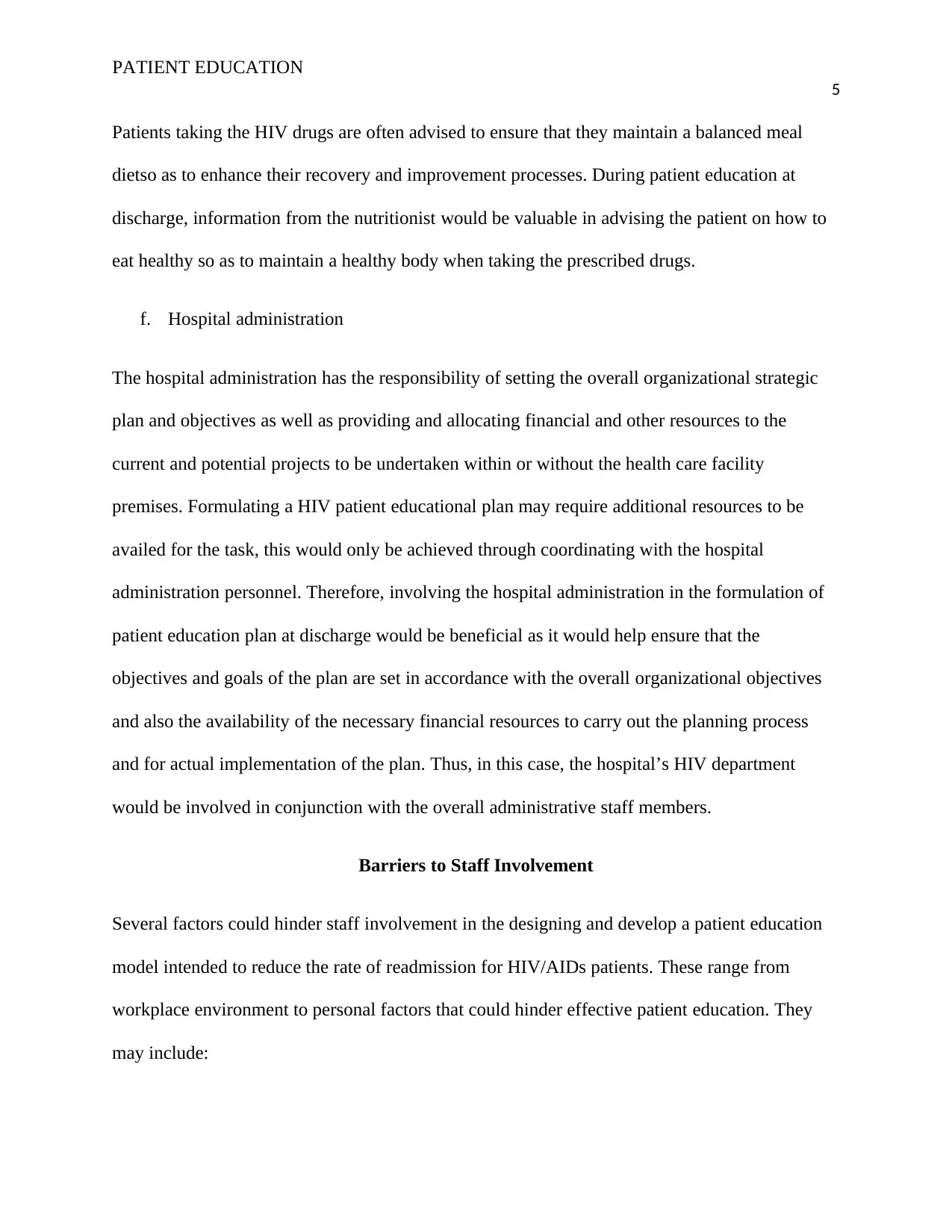
PATIENT EDUCATION
5
Patients taking the HIV drugs are often advised to ensure that they maintain a balanced meal
dietso as to enhance their recovery and improvement processes. During patient education at
discharge, information from the nutritionist would be valuable in advising the patient on how to
eat healthy so as to maintain a healthy body when taking the prescribed drugs.
f. Hospital administration
The hospital administration has the responsibility of setting the overall organizational strategic
plan and objectives as well as providing and allocating financial and other resources to the
current and potential projects to be undertaken within or without the health care facility
premises. Formulating a HIV patient educational plan may require additional resources to be
availed for the task, this would only be achieved through coordinating with the hospital
administration personnel. Therefore, involving the hospital administration in the formulation of
patient education plan at discharge would be beneficial as it would help ensure that the
objectives and goals of the plan are set in accordance with the overall organizational objectives
and also the availability of the necessary financial resources to carry out the planning process
and for actual implementation of the plan. Thus, in this case, the hospital’s HIV department
would be involved in conjunction with the overall administrative staff members.
Barriers to Staff Involvement
Several factors could hinder staff involvement in the designing and develop a patient education
model intended to reduce the rate of readmission for HIV/AIDs patients. These range from
workplace environment to personal factors that could hinder effective patient education. They
may include:
5
Patients taking the HIV drugs are often advised to ensure that they maintain a balanced meal
dietso as to enhance their recovery and improvement processes. During patient education at
discharge, information from the nutritionist would be valuable in advising the patient on how to
eat healthy so as to maintain a healthy body when taking the prescribed drugs.
f. Hospital administration
The hospital administration has the responsibility of setting the overall organizational strategic
plan and objectives as well as providing and allocating financial and other resources to the
current and potential projects to be undertaken within or without the health care facility
premises. Formulating a HIV patient educational plan may require additional resources to be
availed for the task, this would only be achieved through coordinating with the hospital
administration personnel. Therefore, involving the hospital administration in the formulation of
patient education plan at discharge would be beneficial as it would help ensure that the
objectives and goals of the plan are set in accordance with the overall organizational objectives
and also the availability of the necessary financial resources to carry out the planning process
and for actual implementation of the plan. Thus, in this case, the hospital’s HIV department
would be involved in conjunction with the overall administrative staff members.
Barriers to Staff Involvement
Several factors could hinder staff involvement in the designing and develop a patient education
model intended to reduce the rate of readmission for HIV/AIDs patients. These range from
workplace environment to personal factors that could hinder effective patient education. They
may include:
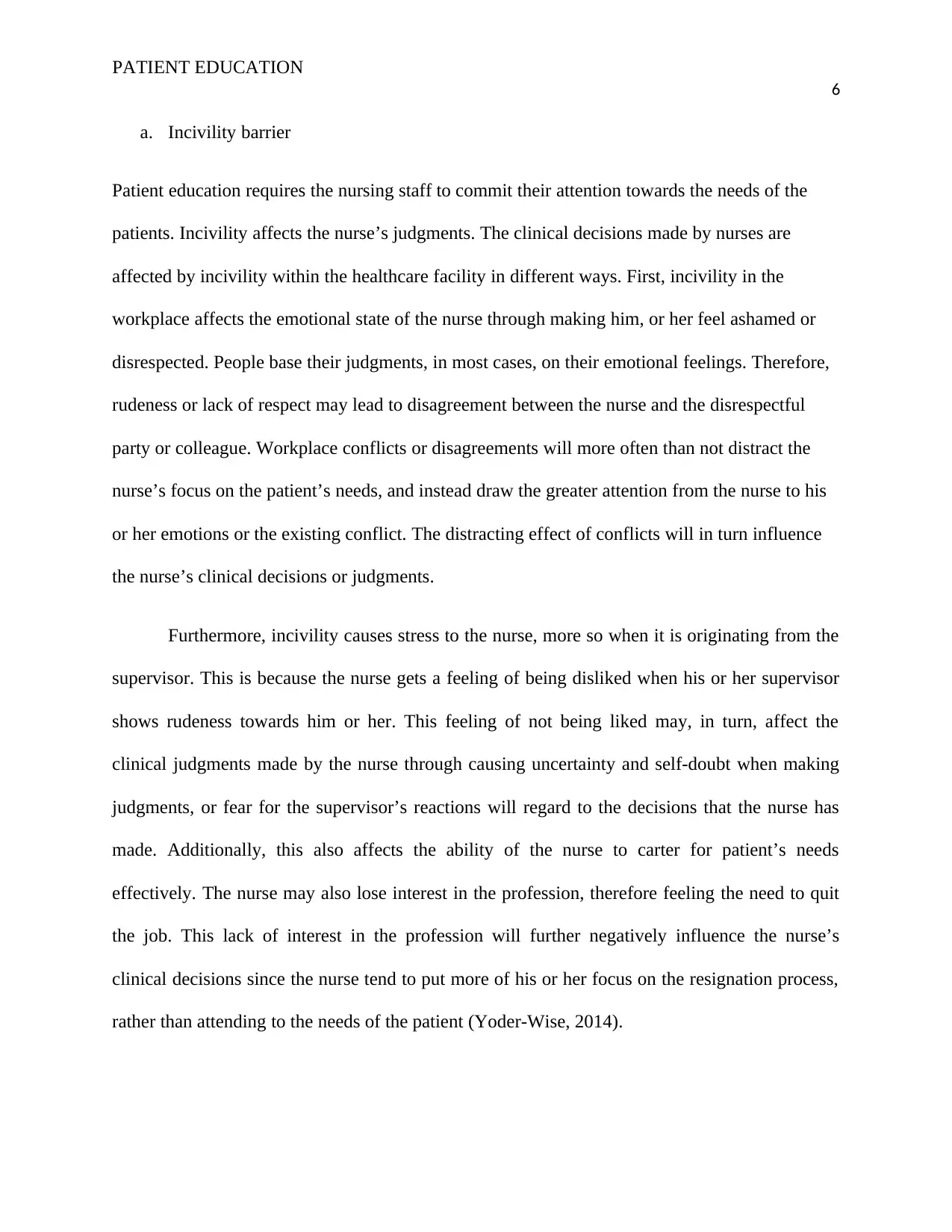
PATIENT EDUCATION
6
a. Incivility barrier
Patient education requires the nursing staff to commit their attention towards the needs of the
patients. Incivility affects the nurse’s judgments. The clinical decisions made by nurses are
affected by incivility within the healthcare facility in different ways. First, incivility in the
workplace affects the emotional state of the nurse through making him, or her feel ashamed or
disrespected. People base their judgments, in most cases, on their emotional feelings. Therefore,
rudeness or lack of respect may lead to disagreement between the nurse and the disrespectful
party or colleague. Workplace conflicts or disagreements will more often than not distract the
nurse’s focus on the patient’s needs, and instead draw the greater attention from the nurse to his
or her emotions or the existing conflict. The distracting effect of conflicts will in turn influence
the nurse’s clinical decisions or judgments.
Furthermore, incivility causes stress to the nurse, more so when it is originating from the
supervisor. This is because the nurse gets a feeling of being disliked when his or her supervisor
shows rudeness towards him or her. This feeling of not being liked may, in turn, affect the
clinical judgments made by the nurse through causing uncertainty and self-doubt when making
judgments, or fear for the supervisor’s reactions will regard to the decisions that the nurse has
made. Additionally, this also affects the ability of the nurse to carter for patient’s needs
effectively. The nurse may also lose interest in the profession, therefore feeling the need to quit
the job. This lack of interest in the profession will further negatively influence the nurse’s
clinical decisions since the nurse tend to put more of his or her focus on the resignation process,
rather than attending to the needs of the patient (Yoder-Wise, 2014).
6
a. Incivility barrier
Patient education requires the nursing staff to commit their attention towards the needs of the
patients. Incivility affects the nurse’s judgments. The clinical decisions made by nurses are
affected by incivility within the healthcare facility in different ways. First, incivility in the
workplace affects the emotional state of the nurse through making him, or her feel ashamed or
disrespected. People base their judgments, in most cases, on their emotional feelings. Therefore,
rudeness or lack of respect may lead to disagreement between the nurse and the disrespectful
party or colleague. Workplace conflicts or disagreements will more often than not distract the
nurse’s focus on the patient’s needs, and instead draw the greater attention from the nurse to his
or her emotions or the existing conflict. The distracting effect of conflicts will in turn influence
the nurse’s clinical decisions or judgments.
Furthermore, incivility causes stress to the nurse, more so when it is originating from the
supervisor. This is because the nurse gets a feeling of being disliked when his or her supervisor
shows rudeness towards him or her. This feeling of not being liked may, in turn, affect the
clinical judgments made by the nurse through causing uncertainty and self-doubt when making
judgments, or fear for the supervisor’s reactions will regard to the decisions that the nurse has
made. Additionally, this also affects the ability of the nurse to carter for patient’s needs
effectively. The nurse may also lose interest in the profession, therefore feeling the need to quit
the job. This lack of interest in the profession will further negatively influence the nurse’s
clinical decisions since the nurse tend to put more of his or her focus on the resignation process,
rather than attending to the needs of the patient (Yoder-Wise, 2014).
⊘ This is a preview!⊘
Do you want full access?
Subscribe today to unlock all pages.

Trusted by 1+ million students worldwide
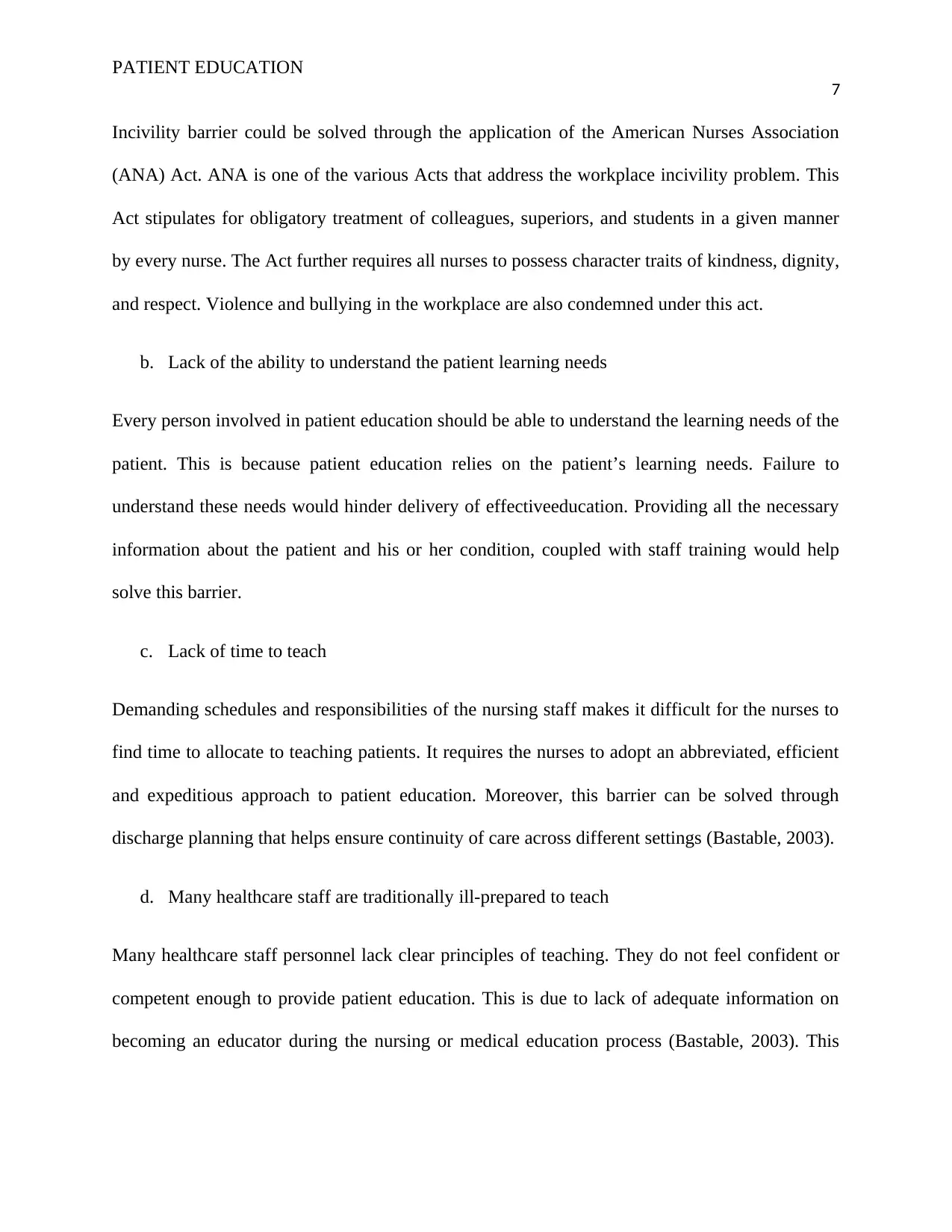
PATIENT EDUCATION
7
Incivility barrier could be solved through the application of the American Nurses Association
(ANA) Act. ANA is one of the various Acts that address the workplace incivility problem. This
Act stipulates for obligatory treatment of colleagues, superiors, and students in a given manner
by every nurse. The Act further requires all nurses to possess character traits of kindness, dignity,
and respect. Violence and bullying in the workplace are also condemned under this act.
b. Lack of the ability to understand the patient learning needs
Every person involved in patient education should be able to understand the learning needs of the
patient. This is because patient education relies on the patient’s learning needs. Failure to
understand these needs would hinder delivery of effectiveeducation. Providing all the necessary
information about the patient and his or her condition, coupled with staff training would help
solve this barrier.
c. Lack of time to teach
Demanding schedules and responsibilities of the nursing staff makes it difficult for the nurses to
find time to allocate to teaching patients. It requires the nurses to adopt an abbreviated, efficient
and expeditious approach to patient education. Moreover, this barrier can be solved through
discharge planning that helps ensure continuity of care across different settings (Bastable, 2003).
d. Many healthcare staff are traditionally ill-prepared to teach
Many healthcare staff personnel lack clear principles of teaching. They do not feel confident or
competent enough to provide patient education. This is due to lack of adequate information on
becoming an educator during the nursing or medical education process (Bastable, 2003). This
7
Incivility barrier could be solved through the application of the American Nurses Association
(ANA) Act. ANA is one of the various Acts that address the workplace incivility problem. This
Act stipulates for obligatory treatment of colleagues, superiors, and students in a given manner
by every nurse. The Act further requires all nurses to possess character traits of kindness, dignity,
and respect. Violence and bullying in the workplace are also condemned under this act.
b. Lack of the ability to understand the patient learning needs
Every person involved in patient education should be able to understand the learning needs of the
patient. This is because patient education relies on the patient’s learning needs. Failure to
understand these needs would hinder delivery of effectiveeducation. Providing all the necessary
information about the patient and his or her condition, coupled with staff training would help
solve this barrier.
c. Lack of time to teach
Demanding schedules and responsibilities of the nursing staff makes it difficult for the nurses to
find time to allocate to teaching patients. It requires the nurses to adopt an abbreviated, efficient
and expeditious approach to patient education. Moreover, this barrier can be solved through
discharge planning that helps ensure continuity of care across different settings (Bastable, 2003).
d. Many healthcare staff are traditionally ill-prepared to teach
Many healthcare staff personnel lack clear principles of teaching. They do not feel confident or
competent enough to provide patient education. This is due to lack of adequate information on
becoming an educator during the nursing or medical education process (Bastable, 2003). This
Paraphrase This Document
Need a fresh take? Get an instant paraphrase of this document with our AI Paraphraser
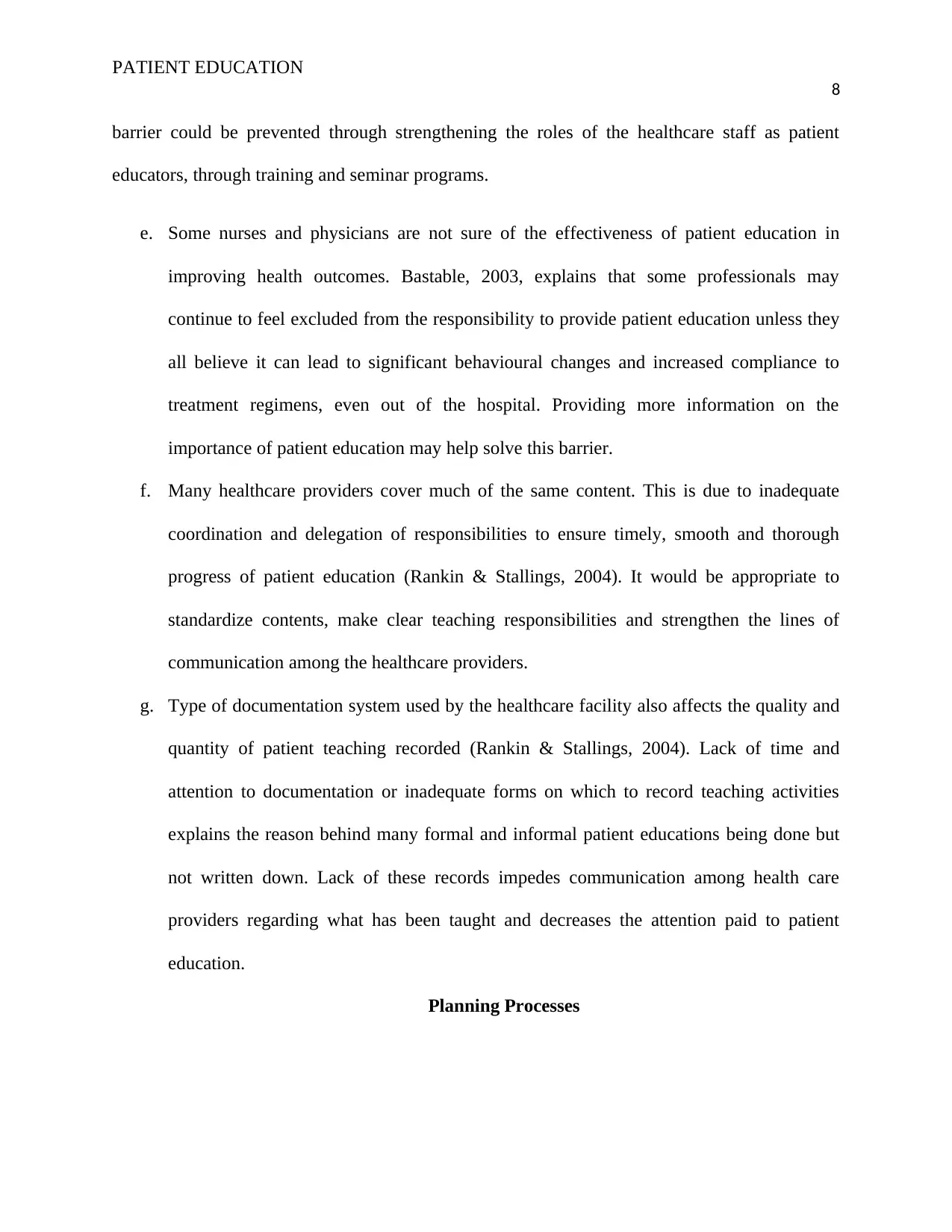
PATIENT EDUCATION
8
barrier could be prevented through strengthening the roles of the healthcare staff as patient
educators, through training and seminar programs.
e. Some nurses and physicians are not sure of the effectiveness of patient education in
improving health outcomes. Bastable, 2003, explains that some professionals may
continue to feel excluded from the responsibility to provide patient education unless they
all believe it can lead to significant behavioural changes and increased compliance to
treatment regimens, even out of the hospital. Providing more information on the
importance of patient education may help solve this barrier.
f. Many healthcare providers cover much of the same content. This is due to inadequate
coordination and delegation of responsibilities to ensure timely, smooth and thorough
progress of patient education (Rankin & Stallings, 2004). It would be appropriate to
standardize contents, make clear teaching responsibilities and strengthen the lines of
communication among the healthcare providers.
g. Type of documentation system used by the healthcare facility also affects the quality and
quantity of patient teaching recorded (Rankin & Stallings, 2004). Lack of time and
attention to documentation or inadequate forms on which to record teaching activities
explains the reason behind many formal and informal patient educations being done but
not written down. Lack of these records impedes communication among health care
providers regarding what has been taught and decreases the attention paid to patient
education.
Planning Processes
8
barrier could be prevented through strengthening the roles of the healthcare staff as patient
educators, through training and seminar programs.
e. Some nurses and physicians are not sure of the effectiveness of patient education in
improving health outcomes. Bastable, 2003, explains that some professionals may
continue to feel excluded from the responsibility to provide patient education unless they
all believe it can lead to significant behavioural changes and increased compliance to
treatment regimens, even out of the hospital. Providing more information on the
importance of patient education may help solve this barrier.
f. Many healthcare providers cover much of the same content. This is due to inadequate
coordination and delegation of responsibilities to ensure timely, smooth and thorough
progress of patient education (Rankin & Stallings, 2004). It would be appropriate to
standardize contents, make clear teaching responsibilities and strengthen the lines of
communication among the healthcare providers.
g. Type of documentation system used by the healthcare facility also affects the quality and
quantity of patient teaching recorded (Rankin & Stallings, 2004). Lack of time and
attention to documentation or inadequate forms on which to record teaching activities
explains the reason behind many formal and informal patient educations being done but
not written down. Lack of these records impedes communication among health care
providers regarding what has been taught and decreases the attention paid to patient
education.
Planning Processes
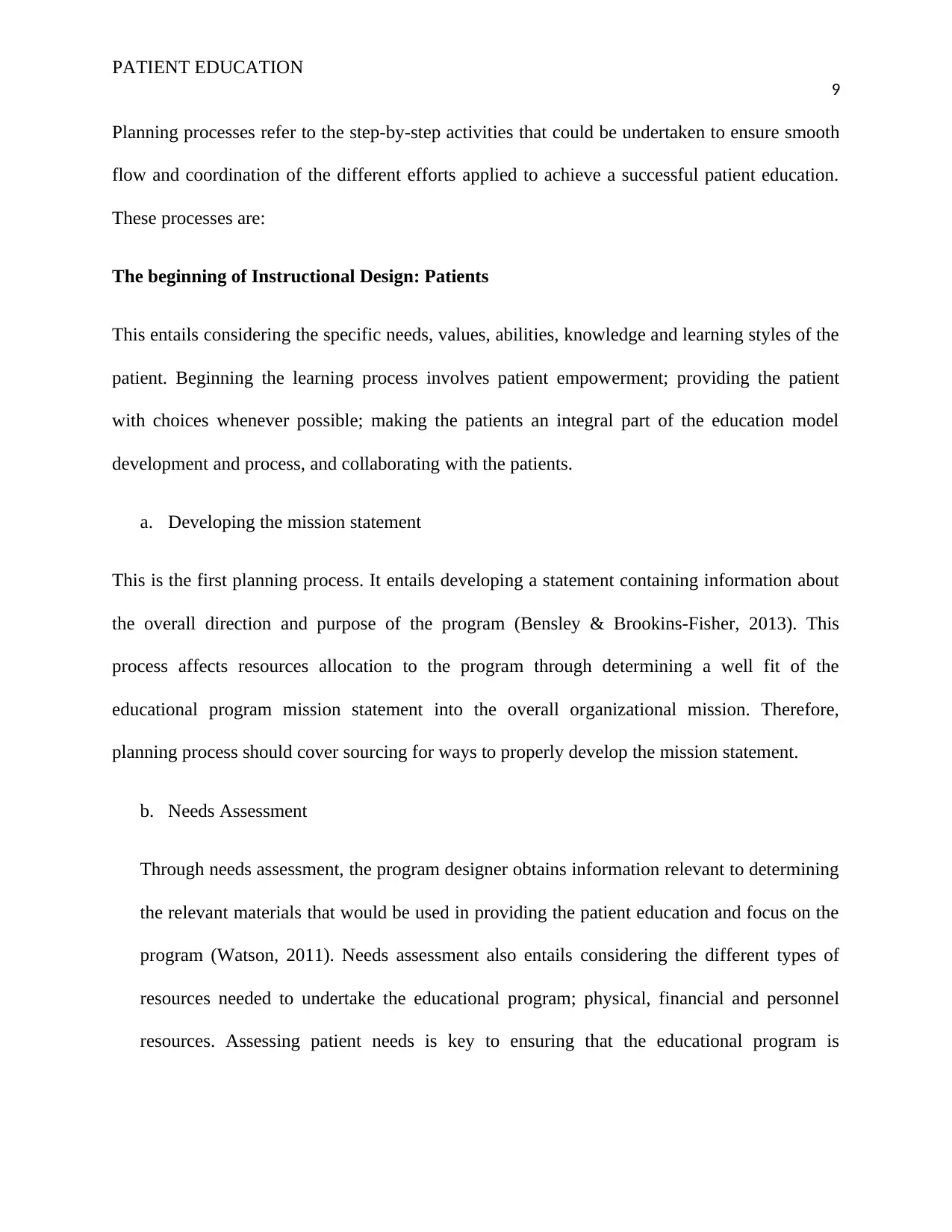
PATIENT EDUCATION
9
Planning processes refer to the step-by-step activities that could be undertaken to ensure smooth
flow and coordination of the different efforts applied to achieve a successful patient education.
These processes are:
The beginning of Instructional Design: Patients
This entails considering the specific needs, values, abilities, knowledge and learning styles of the
patient. Beginning the learning process involves patient empowerment; providing the patient
with choices whenever possible; making the patients an integral part of the education model
development and process, and collaborating with the patients.
a. Developing the mission statement
This is the first planning process. It entails developing a statement containing information about
the overall direction and purpose of the program (Bensley & Brookins-Fisher, 2013). This
process affects resources allocation to the program through determining a well fit of the
educational program mission statement into the overall organizational mission. Therefore,
planning process should cover sourcing for ways to properly develop the mission statement.
b. Needs Assessment
Through needs assessment, the program designer obtains information relevant to determining
the relevant materials that would be used in providing the patient education and focus on the
program (Watson, 2011). Needs assessment also entails considering the different types of
resources needed to undertake the educational program; physical, financial and personnel
resources. Assessing patient needs is key to ensuring that the educational program is
9
Planning processes refer to the step-by-step activities that could be undertaken to ensure smooth
flow and coordination of the different efforts applied to achieve a successful patient education.
These processes are:
The beginning of Instructional Design: Patients
This entails considering the specific needs, values, abilities, knowledge and learning styles of the
patient. Beginning the learning process involves patient empowerment; providing the patient
with choices whenever possible; making the patients an integral part of the education model
development and process, and collaborating with the patients.
a. Developing the mission statement
This is the first planning process. It entails developing a statement containing information about
the overall direction and purpose of the program (Bensley & Brookins-Fisher, 2013). This
process affects resources allocation to the program through determining a well fit of the
educational program mission statement into the overall organizational mission. Therefore,
planning process should cover sourcing for ways to properly develop the mission statement.
b. Needs Assessment
Through needs assessment, the program designer obtains information relevant to determining
the relevant materials that would be used in providing the patient education and focus on the
program (Watson, 2011). Needs assessment also entails considering the different types of
resources needed to undertake the educational program; physical, financial and personnel
resources. Assessing patient needs is key to ensuring that the educational program is
⊘ This is a preview!⊘
Do you want full access?
Subscribe today to unlock all pages.

Trusted by 1+ million students worldwide
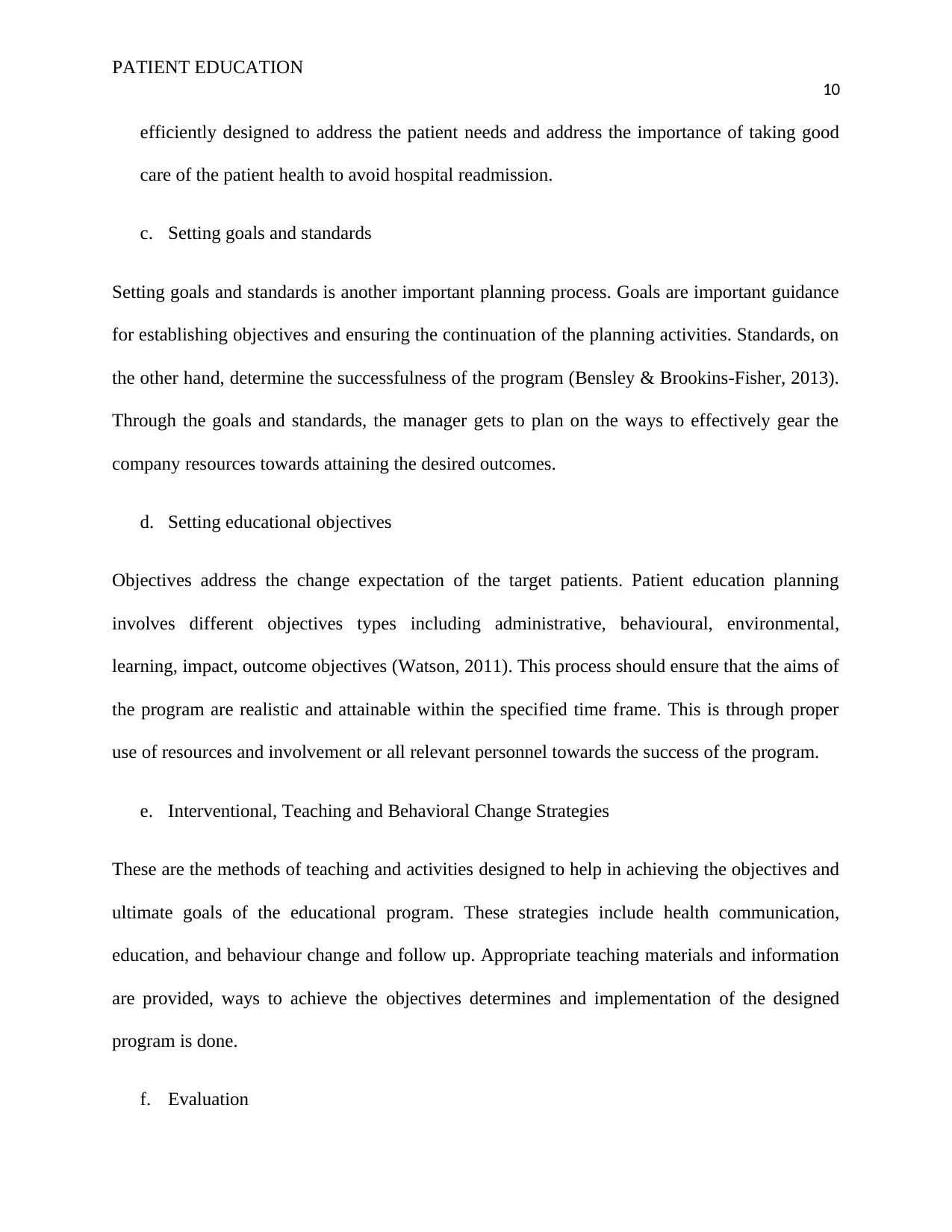
PATIENT EDUCATION
10
efficiently designed to address the patient needs and address the importance of taking good
care of the patient health to avoid hospital readmission.
c. Setting goals and standards
Setting goals and standards is another important planning process. Goals are important guidance
for establishing objectives and ensuring the continuation of the planning activities. Standards, on
the other hand, determine the successfulness of the program (Bensley & Brookins-Fisher, 2013).
Through the goals and standards, the manager gets to plan on the ways to effectively gear the
company resources towards attaining the desired outcomes.
d. Setting educational objectives
Objectives address the change expectation of the target patients. Patient education planning
involves different objectives types including administrative, behavioural, environmental,
learning, impact, outcome objectives (Watson, 2011). This process should ensure that the aims of
the program are realistic and attainable within the specified time frame. This is through proper
use of resources and involvement or all relevant personnel towards the success of the program.
e. Interventional, Teaching and Behavioral Change Strategies
These are the methods of teaching and activities designed to help in achieving the objectives and
ultimate goals of the educational program. These strategies include health communication,
education, and behaviour change and follow up. Appropriate teaching materials and information
are provided, ways to achieve the objectives determines and implementation of the designed
program is done.
f. Evaluation
10
efficiently designed to address the patient needs and address the importance of taking good
care of the patient health to avoid hospital readmission.
c. Setting goals and standards
Setting goals and standards is another important planning process. Goals are important guidance
for establishing objectives and ensuring the continuation of the planning activities. Standards, on
the other hand, determine the successfulness of the program (Bensley & Brookins-Fisher, 2013).
Through the goals and standards, the manager gets to plan on the ways to effectively gear the
company resources towards attaining the desired outcomes.
d. Setting educational objectives
Objectives address the change expectation of the target patients. Patient education planning
involves different objectives types including administrative, behavioural, environmental,
learning, impact, outcome objectives (Watson, 2011). This process should ensure that the aims of
the program are realistic and attainable within the specified time frame. This is through proper
use of resources and involvement or all relevant personnel towards the success of the program.
e. Interventional, Teaching and Behavioral Change Strategies
These are the methods of teaching and activities designed to help in achieving the objectives and
ultimate goals of the educational program. These strategies include health communication,
education, and behaviour change and follow up. Appropriate teaching materials and information
are provided, ways to achieve the objectives determines and implementation of the designed
program is done.
f. Evaluation
Paraphrase This Document
Need a fresh take? Get an instant paraphrase of this document with our AI Paraphraser
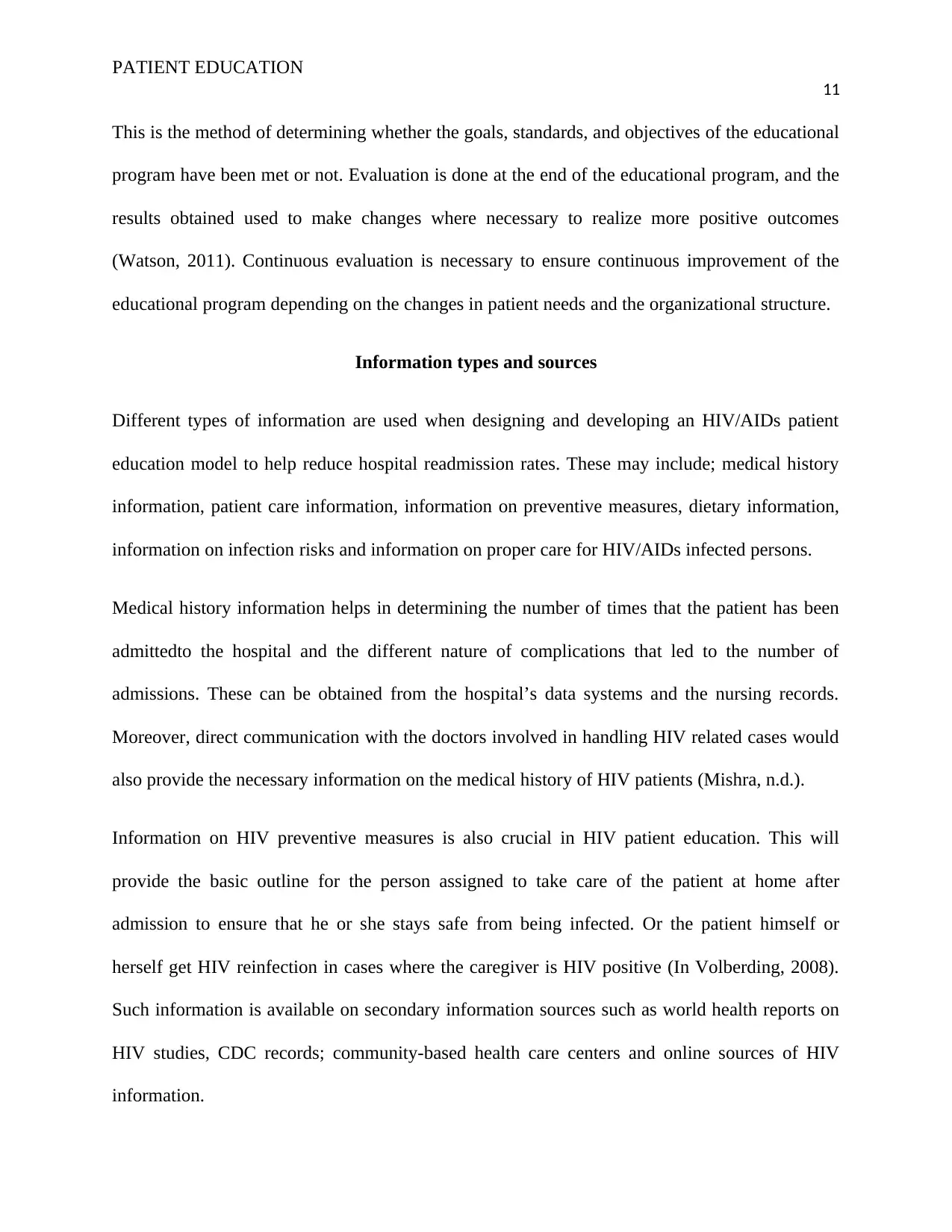
PATIENT EDUCATION
11
This is the method of determining whether the goals, standards, and objectives of the educational
program have been met or not. Evaluation is done at the end of the educational program, and the
results obtained used to make changes where necessary to realize more positive outcomes
(Watson, 2011). Continuous evaluation is necessary to ensure continuous improvement of the
educational program depending on the changes in patient needs and the organizational structure.
Information types and sources
Different types of information are used when designing and developing an HIV/AIDs patient
education model to help reduce hospital readmission rates. These may include; medical history
information, patient care information, information on preventive measures, dietary information,
information on infection risks and information on proper care for HIV/AIDs infected persons.
Medical history information helps in determining the number of times that the patient has been
admittedto the hospital and the different nature of complications that led to the number of
admissions. These can be obtained from the hospital’s data systems and the nursing records.
Moreover, direct communication with the doctors involved in handling HIV related cases would
also provide the necessary information on the medical history of HIV patients (Mishra, n.d.).
Information on HIV preventive measures is also crucial in HIV patient education. This will
provide the basic outline for the person assigned to take care of the patient at home after
admission to ensure that he or she stays safe from being infected. Or the patient himself or
herself get HIV reinfection in cases where the caregiver is HIV positive (In Volberding, 2008).
Such information is available on secondary information sources such as world health reports on
HIV studies, CDC records; community-based health care centers and online sources of HIV
information.
11
This is the method of determining whether the goals, standards, and objectives of the educational
program have been met or not. Evaluation is done at the end of the educational program, and the
results obtained used to make changes where necessary to realize more positive outcomes
(Watson, 2011). Continuous evaluation is necessary to ensure continuous improvement of the
educational program depending on the changes in patient needs and the organizational structure.
Information types and sources
Different types of information are used when designing and developing an HIV/AIDs patient
education model to help reduce hospital readmission rates. These may include; medical history
information, patient care information, information on preventive measures, dietary information,
information on infection risks and information on proper care for HIV/AIDs infected persons.
Medical history information helps in determining the number of times that the patient has been
admittedto the hospital and the different nature of complications that led to the number of
admissions. These can be obtained from the hospital’s data systems and the nursing records.
Moreover, direct communication with the doctors involved in handling HIV related cases would
also provide the necessary information on the medical history of HIV patients (Mishra, n.d.).
Information on HIV preventive measures is also crucial in HIV patient education. This will
provide the basic outline for the person assigned to take care of the patient at home after
admission to ensure that he or she stays safe from being infected. Or the patient himself or
herself get HIV reinfection in cases where the caregiver is HIV positive (In Volberding, 2008).
Such information is available on secondary information sources such as world health reports on
HIV studies, CDC records; community-based health care centers and online sources of HIV
information.
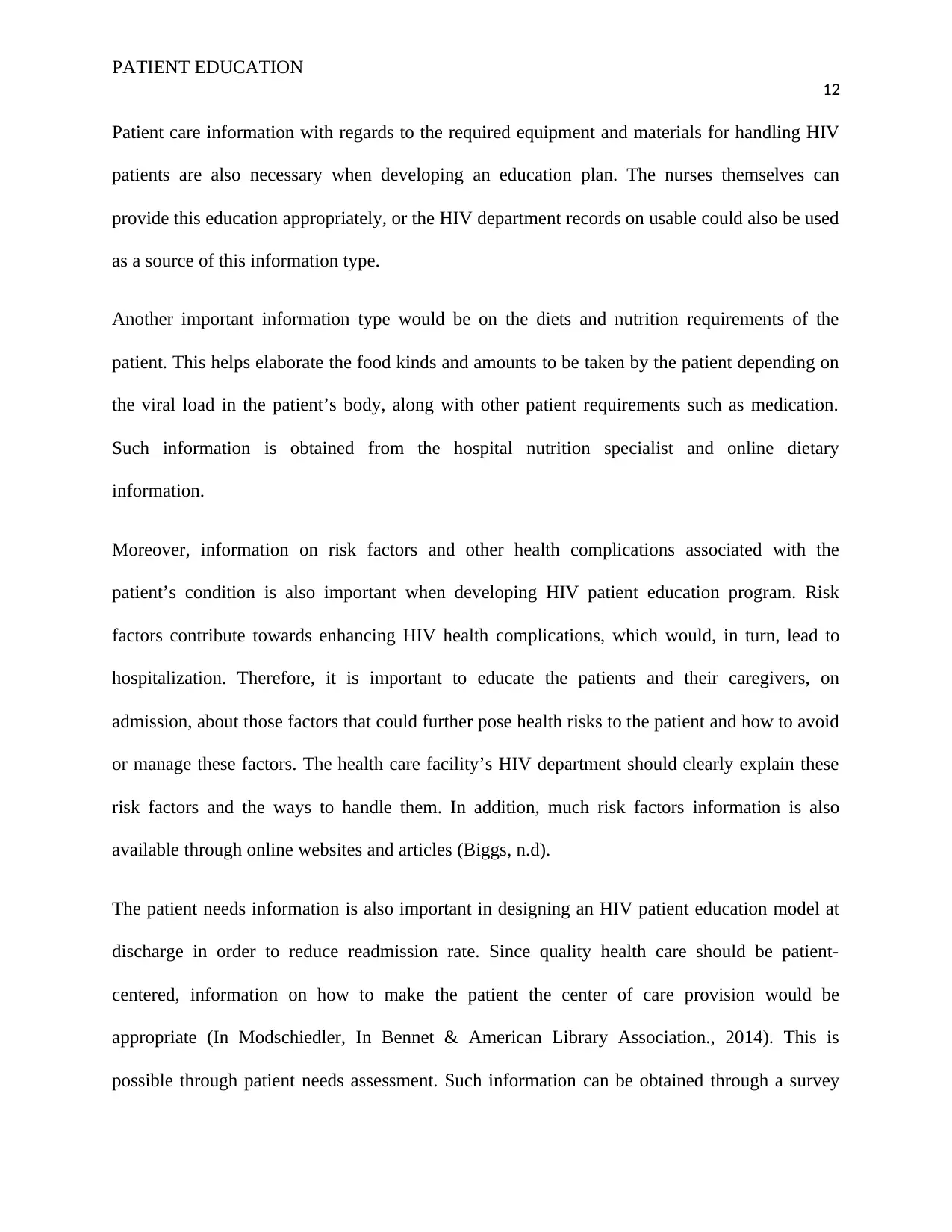
PATIENT EDUCATION
12
Patient care information with regards to the required equipment and materials for handling HIV
patients are also necessary when developing an education plan. The nurses themselves can
provide this education appropriately, or the HIV department records on usable could also be used
as a source of this information type.
Another important information type would be on the diets and nutrition requirements of the
patient. This helps elaborate the food kinds and amounts to be taken by the patient depending on
the viral load in the patient’s body, along with other patient requirements such as medication.
Such information is obtained from the hospital nutrition specialist and online dietary
information.
Moreover, information on risk factors and other health complications associated with the
patient’s condition is also important when developing HIV patient education program. Risk
factors contribute towards enhancing HIV health complications, which would, in turn, lead to
hospitalization. Therefore, it is important to educate the patients and their caregivers, on
admission, about those factors that could further pose health risks to the patient and how to avoid
or manage these factors. The health care facility’s HIV department should clearly explain these
risk factors and the ways to handle them. In addition, much risk factors information is also
available through online websites and articles (Biggs, n.d).
The patient needs information is also important in designing an HIV patient education model at
discharge in order to reduce readmission rate. Since quality health care should be patient-
centered, information on how to make the patient the center of care provision would be
appropriate (In Modschiedler, In Bennet & American Library Association., 2014). This is
possible through patient needs assessment. Such information can be obtained through a survey
12
Patient care information with regards to the required equipment and materials for handling HIV
patients are also necessary when developing an education plan. The nurses themselves can
provide this education appropriately, or the HIV department records on usable could also be used
as a source of this information type.
Another important information type would be on the diets and nutrition requirements of the
patient. This helps elaborate the food kinds and amounts to be taken by the patient depending on
the viral load in the patient’s body, along with other patient requirements such as medication.
Such information is obtained from the hospital nutrition specialist and online dietary
information.
Moreover, information on risk factors and other health complications associated with the
patient’s condition is also important when developing HIV patient education program. Risk
factors contribute towards enhancing HIV health complications, which would, in turn, lead to
hospitalization. Therefore, it is important to educate the patients and their caregivers, on
admission, about those factors that could further pose health risks to the patient and how to avoid
or manage these factors. The health care facility’s HIV department should clearly explain these
risk factors and the ways to handle them. In addition, much risk factors information is also
available through online websites and articles (Biggs, n.d).
The patient needs information is also important in designing an HIV patient education model at
discharge in order to reduce readmission rate. Since quality health care should be patient-
centered, information on how to make the patient the center of care provision would be
appropriate (In Modschiedler, In Bennet & American Library Association., 2014). This is
possible through patient needs assessment. Such information can be obtained through a survey
⊘ This is a preview!⊘
Do you want full access?
Subscribe today to unlock all pages.

Trusted by 1+ million students worldwide
1 out of 17
Related Documents
Your All-in-One AI-Powered Toolkit for Academic Success.
+13062052269
info@desklib.com
Available 24*7 on WhatsApp / Email
![[object Object]](/_next/static/media/star-bottom.7253800d.svg)
Unlock your academic potential
Copyright © 2020–2025 A2Z Services. All Rights Reserved. Developed and managed by ZUCOL.





